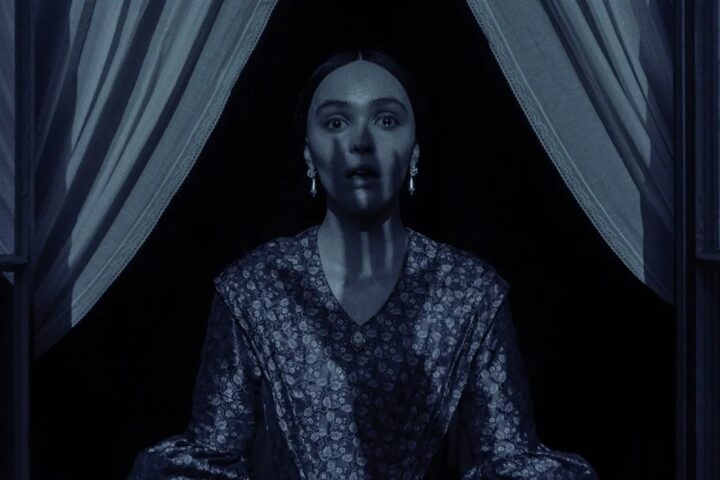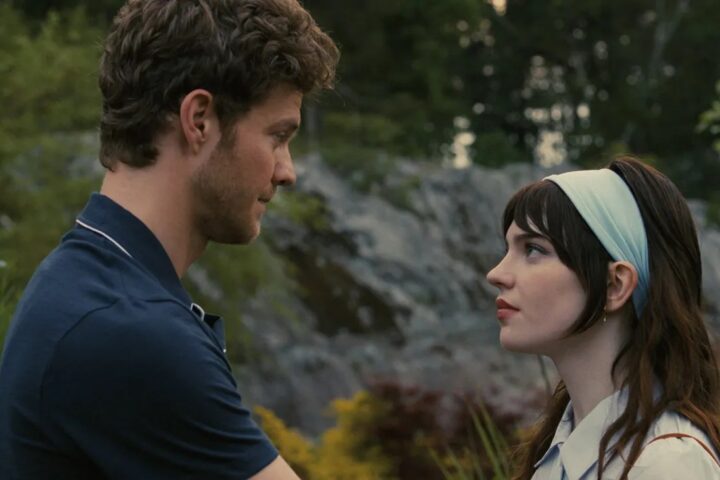The Ochi, a small mystical creature feared by a remote Carpathian village in writer-director Isaiah Saxon’s The Legend of Ochi, speak in a language that operates in a musical and emotional capacity. A similar linguistic spirit is evinced by the film itself. Mercifully for the audience’s eardrums, that doesn’t mean that Saxon gives his debut feature over to the animals’ shrill, screeching form of oral communication. Rather than simply utilizing language to convey information as humans do, he’s more attuned to more melodic and mysterious ways of using it.
Saxon operates in well-trod territory with his original yarn, with the likes of Steven Spielberg and Jim Henson looming large as visual and narrative touchstones. In the film, an isolated teenager named Yuri (Helena Zengel) comes into contact with a trapped baby Ochi and refuses to give into the terror of the unknown conditioned by her father (a hammy but heartwarming Willem Dafoe). Once the girl and the animal form a bond of trust, she defies her small village by embarking on a mission to reunite the Ochi with its family. Along the way, the duo achieves an unexpected symbiosis when Yuri learns to speak and understand the Ochi language.
When it comes to films channeling the spirit of E.T. the Extraterrestrial, The Legend of Ochi stands apart from others for not settling for standard mimicry. Saxon is committed to never straying from the mythological quality of his story. His grasp of the specifics in this fictitious world is such that he authored a 50-page “special report” In Search of the Ochi that’s now being used by A24 as marketing collateral. But none of that minutiae bogs down the film. It’s evident enough in the details of the matte paintings and the specificity of the old-school puppetry used to animate the Ochi. Saxon thankfully possesses the confidence to let the work sell itself.
While the filmmaker spares his characters from becoming backstory-spewing functionaries, a little more development for Yuri and her adopted brother, Petro (Finn Wolfhard), might have helped them play as more than archetypes. But the film, like the best folkloric-inspired sagas, knows to nurture above all the needs of the audience. These fables speak to an experience larger than any one individual, reaffirming values—in this case harmony with nature, acceptance of difference, and healthy skepticism of authority—worth passing down through generations.
The Legend of Ochi is such a welcome sight not just because it cares about something other than pushing its youngest viewers into buying branded toys. Saxon understands that the epic and the intimate can work together across Yuri and the Ochi’s odyssey. The film invokes a consistent sense of wonder and awe through the sweep of a fantasy, captured most noticeably in David Longstreth’s soaring, John Williams-esque score. And it achieves this grandiose awe without sacrificing a more homespun quality that extends beyond merely Saxon’s favoring of practical effects. A simplicity of spirit guides the entirety of The Legend of Ochi, especially when capturing the dynamic between the story’s two central figures.
Saxon pays plenty of homage to his influences throughout The Legend of Ochi, but he dances defiantly and delightfully to the beat of his own drum. This isn’t just a self-serious hero’s journey. He excitingly navigates many tonal swings along the route to the Ochi’s home, with everything from off-kilter comedy to light body horror and even some family drama when Yuri encounters her estranged mother, Dasha (Emily Watson). It’s a remarkable gesture of faith in the audience that reaffirms one of the film’s core messages: that children are smart enough to make sense of the contradictions swirling around them.
Despite its relative scarcity of settings and characters, The Legend of Ochi feels big in a way that suggests the boundlessness of a child’s capacity for imagination. Every choice in the film ladders back to its mission of emulating the empathy experienced by Yuri when she comes to appreciate a newly opened way of communing with the world around her. Saxon’s coupling of a tactile approach to fleshing out his imaginative vision with a sincere treatment of the mythic material supplies age-spanning movie magic that doesn’t just speak in the language of emotions. It sings.
Since 2001, we've brought you uncompromising, candid takes on the world of film, music, television, video games, theater, and more. Independently owned and operated publications like Slant have been hit hard in recent years, but we’re committed to keeping our content free and accessible—meaning no paywalls or fees.
If you like what we do, please consider subscribing to our Patreon or making a donation.




